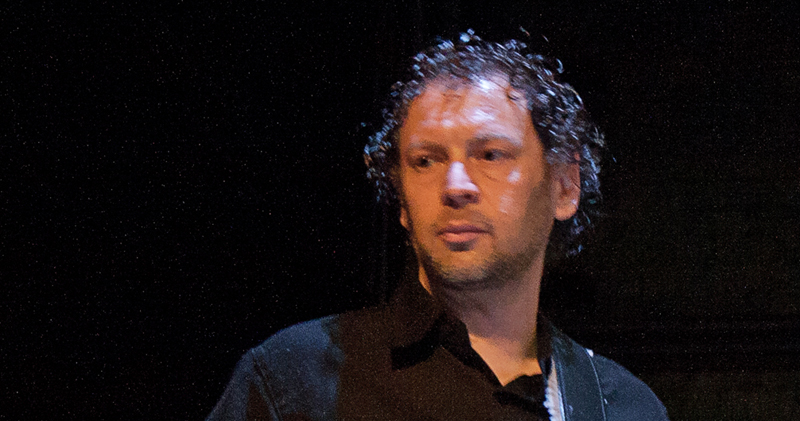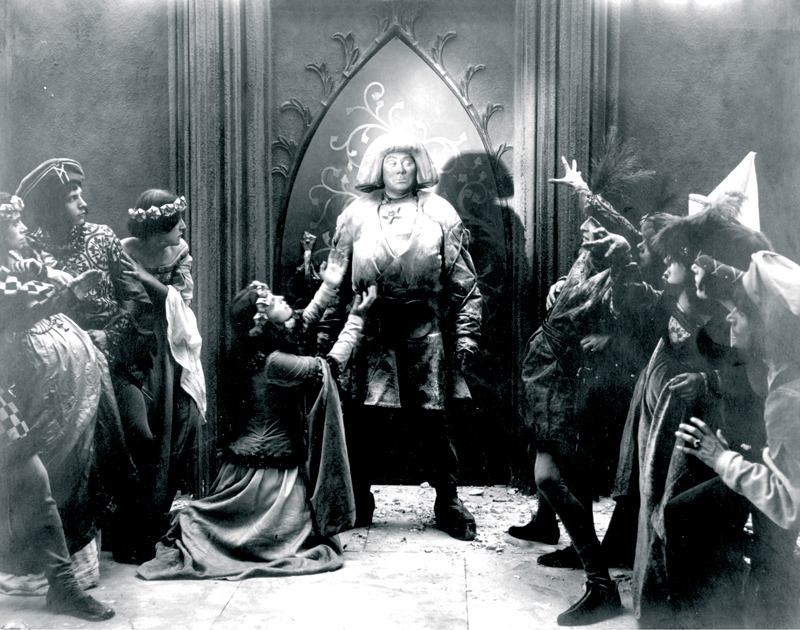
Photo by Benjamin Coopersmith, courtesy of JCDE.
The silent expressionist masterpiece, Der Golem, wie er in die Welt kam, [The Golem: How He Came into the World] captivated audiences in 1920 when it was first released.
It was a retelling of a medieval Jewish story about a rabbi who calls upon divine forces to animate a ‘man’ made of clay—much as God created Adam—in order to protect his people from the Holy Roman Empire. Of course, humans are not able to control divine forces, and the Golem proves difficult to manage as he rampages through the Bohemian ghettos of the Dark Ages.
The Jack Curtis Dubowsky Ensemble will be performing an original musical score for the film, which will accompany a screening this Saturday at the Cultural Alliance for Long Beach. The Ensemble includes Alicia Byer on clarinet, Jeff Schwartz on double bass, Charles Sharp on saxophone, and Dubowsky on keyboard. The screening and performance, which begin at 8:00PM, are part of an ongoing series called Excursions, curated by Dave Williams, a well-loved local composer, producer, and band leader of MBT.
By day, Dubowsky is the music editor on Beauty and the Beast, a scripted drama on the CW.
Long Beach Post: What is it that connected you to the film?
Jack Curtis Dubowsky: While some laud The Golem as a precursor to James Whale’s Frankenstein (1931), The Golem is also about technology and violence. The Golem is basically a weapon. Once that weapon is unleashed, it can’t be controlled. That resonates with our nation’s fixation with technology, violence, and military solutions; when all you have is a hammer, every problem looks like a nail. The Golem was made shortly after The Great War, and while it’s set in the 1500s, you can feel the shadow of WWI’s out-of-control militarism.
Another facet of The Golem is the portrayal of a Jewish community that was not assimilated into the white European establishment; the Jews are portrayed as likable, superstitious, irrational, magical people with silly hats. The way the Holy Roman Emperor deals with the Ghetto and the Jews, by decree without cultural understanding or appreciation, eerily foreshadows not only World War 2, but also the way the West currently deals with the whole Middle East. In some ways, The Golem is like a giant, out of control drone; he’s made of clay, he’s not a man, but he is able to do the dirty work. Who has the moral responsibility for his actions?

How did you approach the score?
Like any film, first I watch the film many many times. Then I “spot” the film musically, which is to say, I decide where music should go. But as it’s a silent film, the music is nearly continuous throughout.
The next step is to break it down into “cues.” Each “cue” is a little bit of the film, maybe a scene, with its transitions perhaps, that is complemented by a coherent piece of music. I compose a bunch of themes that are notated. The players have that written out in standard notation, and we also have a book of cues that follows the film, that gives instructions for what each player does. [That allows] room for improvisation and gestural accompaniment.
Can you give an example of an instruction that’s not part of the notated score?
We have a bit of what we call “mickey-mousing,” which just means to follow a certain action. So the bass part might say “MM Golem Footsteps” and, in that cue, the bass follows the Golem’s foot steps. We also have some dialogue. For example, there’s a scene where Miriam is whining and her father, Rabbi Jehuda, is angry and barks at her so, rather than write something fussy out, I just instruct “MM Miriam” or “MM Jehuda” and the instruments imitate their “voice” or their gestures.
Other things are not written out: we have the effects of wind and fire, for example, and an earthquake, so instruments can do these textural effects very easily without having to write something out in a fussy way. And everyone has their own part, so one instrument might be doing a texture; one might be MM a character; one might be playing a notated theme. The “cue book” is like a giant flow chart. It’s complicated, but it works. The notated themes are on separate pages, so everyone has two music stands.
This is a rather monumental effort. What made you bring it to Long Beach?
I live in Long Beach. Charles does too. Jeff Schwartz, our amazing bass player, was playing a gig right here at the 729 Pine venue, and that was booked by local trumpeter and impresario Dave Williams. So we talked to Dave about doing the show, and he booked us for his series.
What does it mean, as a composer, to have a group of individuals who you know well, and for whom you can consistently write?
That’s a really great thing if you can find it! When I was in San Francisco, I wrote a ton of choral music for one particular chorus because my friend, whom I’d gone to conservatory with, was their conductor. I had another friend who conducted a local orchestra, so was able to write some stuff for them. If you have people [who] you can write for consistently, it helps get you out there, helps keep your skills in tune.
As far as JCDE, for having consistent players, that’s really good for having really good improv and things like that. If you have a consistent cadre of players, they understand what you are going after, what playing styles and approaches work with the group, and so on. A lot of different musicians have played with JCDE since I started doing it in 2008. I think the ideas are fairly transportable.
I know that there are many highly-trained musicians who don’t get to earn a living with their art. Is the academic experience worth the investment?
Oh yeah. You don’t pursue Conservatory because you expect to earn a living. You do it because you want to write or play better music. Or learn about music. I think, for me, studying music was a very profound thing.
I studied counterpoint with Conrad Susa, who passed away recently. With Conrad, you could go down the rabbit hole looking at some minute detail of counterpoint. There might be pages and pages of music, but you would look at this one strange note, and it would be like “What is THIS NOTE doing???” And why it was there, what made it special, where else in the score this motion could have come from, or was an imitation of? There was just an endless depth and complexity that you were suddenly aware of. You can spend hours, days, or a lifetime looking at one Bach Fugue.
I think this level of obsession can exist in all forms of music: I’ve seen EDM people obsess about a snare drum sound, for instance. It’s just about discipline: music as a discipline, something that you can follow and learn about and try to understand as best as you can.
Tell me about the big academic project you’ve been working on.
I am in the late stages of completing my monograph, Intersecting Film, Music, and Queerness which is under contract to Palgrave MacMillan. A monograph is ‘academic speak’ for a book by one author. Basically the book will look at the intersections of the fields of musicology, cinema studies, and queer theory.
So… Something like Xanadu?
[Laughs] Xanadu is not one of the films I look at, but there’s certainly a lot you could do with Xanadu!
For me, it was the Dolphin shorts.
[Laughs] They used to be the rage, Dolphin shorts!
How did you come to this topic?
I had been attending academic conferences and presenting papers. These conferences also attract academic presses and editors, and they check out what people are doing. The response to the kind of work I was doing was really strong. People found the papers entertaining, and I got pushed into doing journal articles, then book proposals, then I got a contract for the book. The book evolved out of work that I was doing and ideas that I was developing.
What did getting that contract mean to you, personally and professionally?
Personally, it meant a year of crazy work to write a book. Professionally, I’m not sure yet. I’m looking forward to seeing what its impact and influence in the academy will be. As far as “show biz,” I doubt anyone will even hear about it!
As an artist, how does living in Long Beach affect your work?
Being close to the hub of Los Angeles has enabled me to get work in show business. So that’s good. My work as a composer and a writer I could really do from anywhere. Long Beach I find is much more livable than LA. And it’s inexpensive. And it’s close to really great surfing in HB. So it’s a nice combination of variables. SoCal has some really great players. It’s been a great experience meeting all these wonderful players down here.
To learn more about Jack and his work, visit jackcurtisdubowsky.com.
To learn more about the Cultural Alliance of Long Beach, visit their facebook page.
Read an interview with Dave Williams.
{FG_GEOMAP [33.7759713,-118.19242059999999] FG_GEOMAP}

